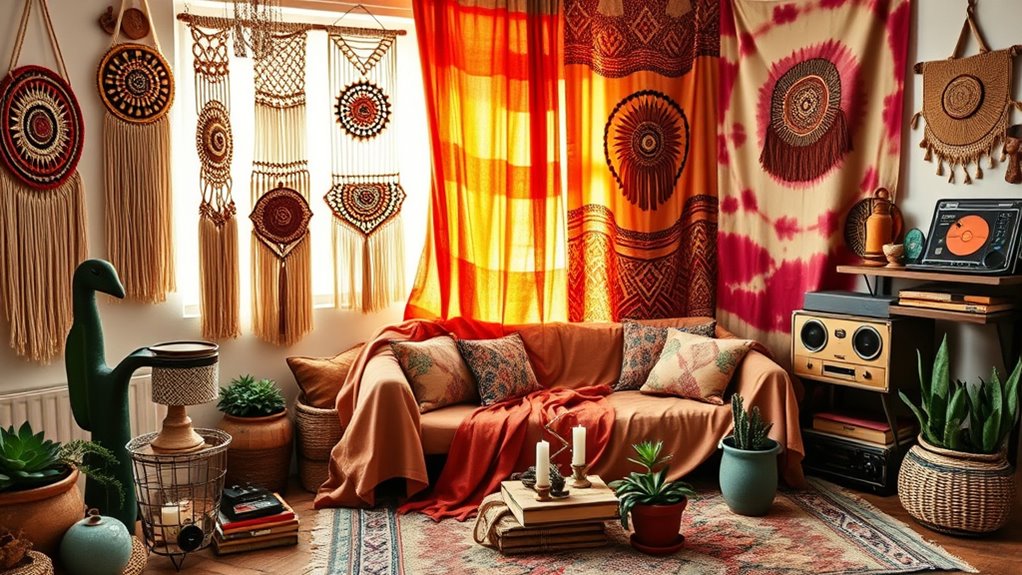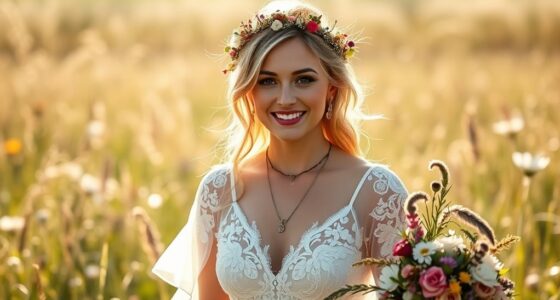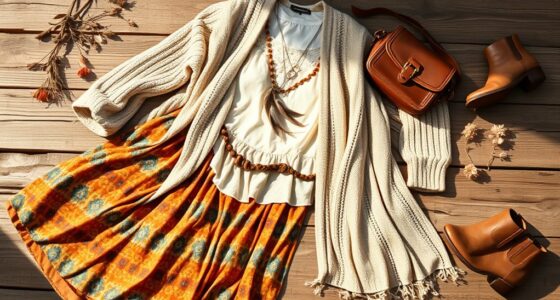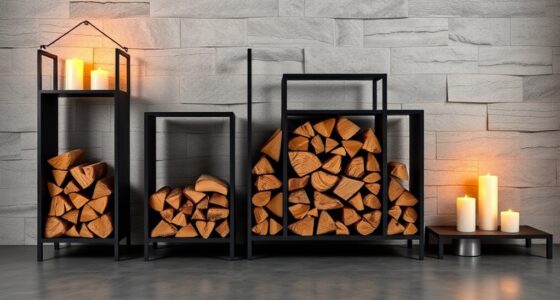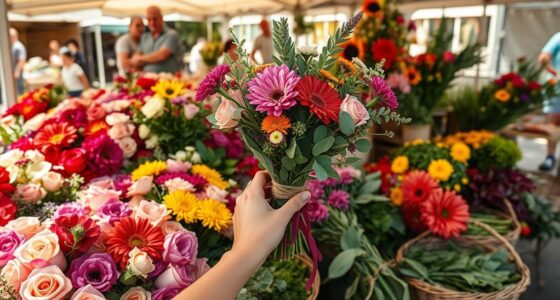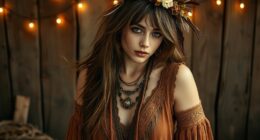The boho style started in the 1960s as a counterculture movement, inspired by ethnic patterns, flowing fabrics, and natural materials. Influenced by figures like Stevie Nicks and Talitha Getty, it spread through festivals and vintage shops. In recent decades, it’s revived with sustainable practices and modern twists, blending vintage with eco-friendly fabrics. If you keep exploring, you’ll discover how this free-spirited look continues to evolve and influence today’s fashion world.
Key Takeaways
- Boho style originated in the 1950s as a relaxed, ethnic-inspired response to formal fashion, influenced by global motifs and counterculture movements.
- The 1960s and 1970s Woodstock era popularized boho with maxidresses, layered jewelry, and natural materials, shaping its free-spirited identity.
- In the 2000s, celebrities and fast fashion revived boho, introducing variations like boho-chic and blending vintage with modern styles.
- Contemporary boho emphasizes sustainability, using eco-friendly fabrics, fair trade collaborations, and promoting ethical craftsmanship.
- Modern trends incorporate cultural heritage, eco-conscious materials, and versatile styling to keep boho relevant in mainstream fashion.
The Birth of Boho: Roots in the 1960s Counterculture
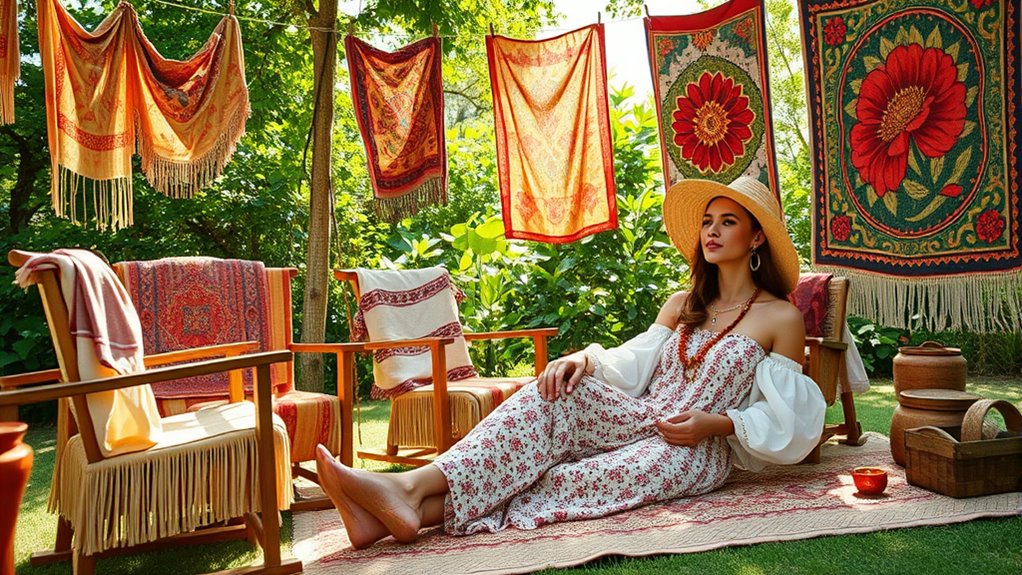
The birth of boho style in the 1960s was a direct response to the rigid fashion of the previous decade. During this era, the counterculture and hippie movement rejected formal, conservative clothing, embracing a more relaxed, expressive look. You’d notice ethnic-inspired patterns, flowing fabrics, and earthy tones becoming central to this style, symbolizing peace and cultural diversity. The Woodstock festival in 1969 was a pivotal moment, where maxidresses, caftans, and handmade jewelry gained popularity among youth seeking freedom and individuality. Influenced by a desire to break boundaries, boho fashion drew from Native American, Middle Eastern, and Eastern European motifs, reflecting a global interconnectedness. Additionally, the color palette of the era often featured warm, natural hues that complemented the style’s emphasis on harmony with nature. This movement set the foundation for a fashion that celebrates personal expression and cultural mixing, with the fashion trends of the time continuing to influence modern boho styles. The integration of natural materials like leather, beads, and feathers further emphasized the movement’s connection to the earth and authenticity. The focus on cultural influences also helped pave the way for more diverse and inclusive fashion expressions in later decades.
Key Figures and Artistic Inspirations Shaping Boho Fashion
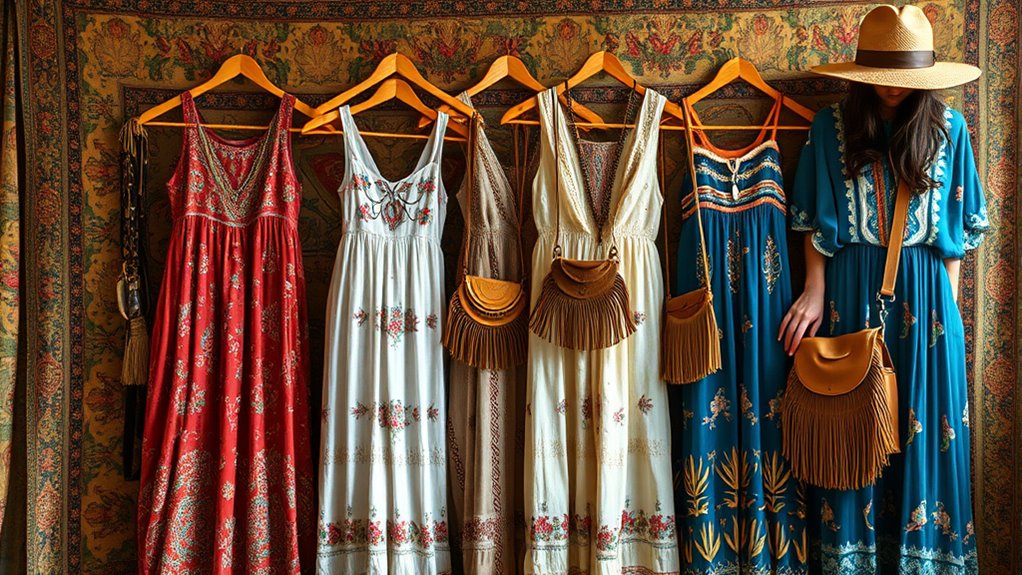
As boho fashion gained popularity in the 1960s and 1970s, influential figures and artists played a pivotal role in shaping its distinctive style. Stevie Nicks and Janis Joplin popularized boho looks with fringe, chiffon, and layered jewelry, embodying the free-spirited vibe. Talitha Getty’s eclectic wardrobes from her travels inspired bohemian aesthetics in fashion and interiors. Yves Saint Laurent’s collections, like the 1976 “Ballet Russes,” incorporated folkloric and exotic influences, emphasizing ornate blouses and headwraps. Early inspirations also come from Paul Poiret, who introduced Asian and Middle Eastern elements such as caftans and harem pants. These figures and artistic inspirations reflect the vibrant colors, relaxed silhouettes, and the rebellious spirit of the bohemian movement. Additionally, artistic inspiration from various cultures and eras continues to influence boho fashion design today, highlighting the importance of cultural fusion in creating its eclectic appeal. The use of eclectic patterns and textures further exemplifies how diverse influences merge to define boho style, and ongoing cultural exchanges keep the trend fresh and dynamic in contemporary fashion. Moreover, the incorporation of vintage elements helps sustain the nostalgic and timeless nature of boho fashion, connecting past influences with modern trends.
The Revival and Expansion of Boho Style in the 2000s
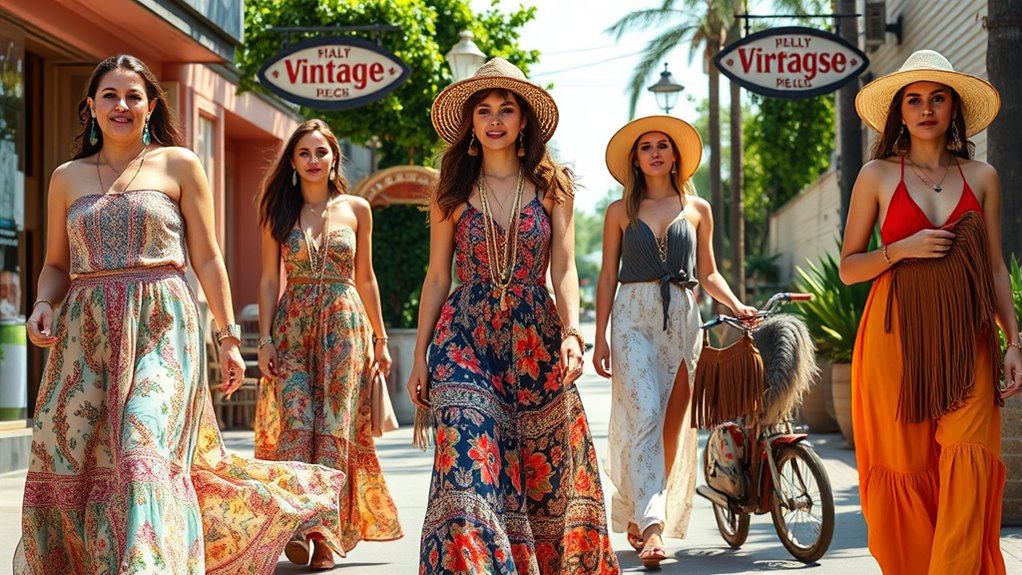
In the 2000s, boho style experienced a major revival, thanks to celebrities like Sienna Miller and Kate Moss who made layered, flowy outfits popular. Fast fashion brands embraced boho-inspired pieces, making the look more accessible to everyone. At the same time, sustainability and eco-friendly materials gained importance, shaping the movement’s modern expansion. Additionally, the rise of ethical fashion fostered innovative thinking and collaboration within organizations, paralleling how boho style encourages creative expression and individualism. Furthermore, the influence of global economic factors and consumer demand for responsible fashion choices contributed to the sustainable growth of boho-inspired trends. Recognizing the importance of sustainable practices, many brands integrated eco-conscious materials into their collections, further aligning the movement with contemporary values.
Celebrity Influences and Trends
Celebrity influence played a pivotal role in reviving and expanding boho style during the 2000s, making it a mainstream fashion trend. Fashion icons like Sienna Miller and Kate Moss showcased boho chic with flowy skirts, embroidered tunics, and layered jewelry, inspiring countless fans. The Olsen twins embraced vintage-inspired looks, encouraging relaxed, eclectic styles among young women. Vanessa Hudgens and Nicole Richie popularized festival outfits, featuring fringe vests, floral crowns, and oversized sunglasses, fueling the trend’s popularity. High-end brands such as Chloé and Roberto Cavalli incorporated bohemian elements into their runway collections, elevating the style’s chic appeal. These celebrity endorsements, combined with festival culture and vintage shopping, propelled boho style into modern trends. The fashion industry also played a role in mainstreaming boho aesthetics through seasonal collections and marketing campaigns, further cementing its place in contemporary fashion. Furthermore, the growing emphasis on sustainable fashion has encouraged designers and consumers alike to incorporate more natural materials and eco-friendly practices into boho-inspired clothing, reinforcing its connection to environmental consciousness. Additionally, innovations in ethical fashion have fostered more transparent supply chains, attracting consumers who value sustainability and social responsibility.
Sustainable and Ethical Focus
The 2000s saw a significant shift in boho style, with sustainability and ethics taking center stage. You’ll notice brands embracing sustainable fashion by using eco-friendly fabrics like organic materials and recycled textiles, reducing environmental impact. Many designers collaborated with fair-trade artisans and prioritized ethical manufacturing, ensuring fair wages and safe working conditions. The rise of digital printing enabled detailed, vibrant patterns on eco-certifications-approved fabrics, further supporting eco-conscious choices. Consumers increasingly prefer vintage and thrifted boho pieces, promoting reuse and cutting down on fast fashion waste. Modern boho brands also emphasize transparent supply chains, showcasing their commitment to ethical standards. This eco-aware approach helped redefine boho as not just stylish but also responsible, resonating with socially conscious shoppers. Sustainable fabrics became a key element in the evolution of boho fashion, highlighting the movement’s shift toward environmentally friendly practices. Additionally, the integration of ethical manufacturing practices has encouraged more brands to adopt fair labor standards across the supply chain. The emphasis on proper drivetrain care and responsible sourcing has further supported the movement toward sustainable fashion. Furthermore, advances in environmental innovations such as eco-friendly dyeing and waste reduction techniques have contributed to more sustainable production processes in the industry. As consumer awareness grows, the demand for legally compliant and ethically sourced materials continues to influence industry standards and practices.
Mainstream Adoption and Variations of Boho in Contemporary Fashion
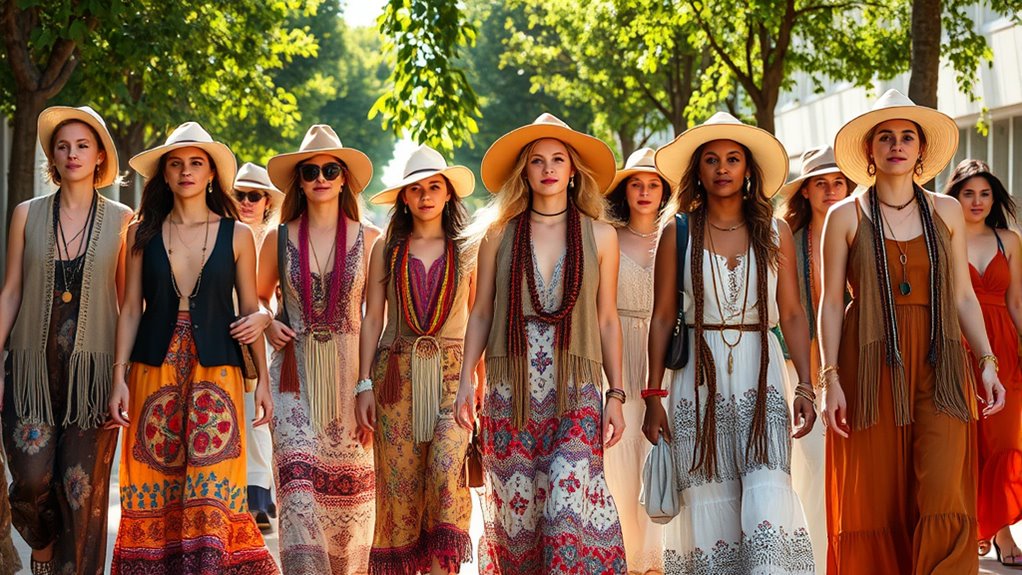
Boho style has seamlessly entered mainstream fashion, thanks to high-end runway shows, fast fashion brands, and celebrity influence, making it accessible to a wide audience. Today’s boho-inspired looks include variations like boho-chic, minimalist boho, and edgy boho, allowing you to adapt the style for any occasion. Popular items such as tiered skirts, embroidered jackets, and statement kimonos are now found everywhere, from luxury boutiques to affordable stores. The style’s versatility lets you mix patterns, layer accessories, and combine vintage with modern fabrics. This adaptability keeps bohemian style fresh and relevant, blending its roots with contemporary trends. Incorporating self-watering plant pots into your home decor can also reflect the eclectic and practical spirit of boho aesthetics. Cultural intelligence can help you appreciate and incorporate diverse cultural elements into your personal style, making it more authentic and respectful. Interior design principles, such as layering textures and mixing patterns, further enhance the boho vibe. Whether you prefer a laid-back or more polished look, the variations of boho fashion give you endless ways to express your unique style.
Sustainable and Ethical Influences on Modern Boho Trends
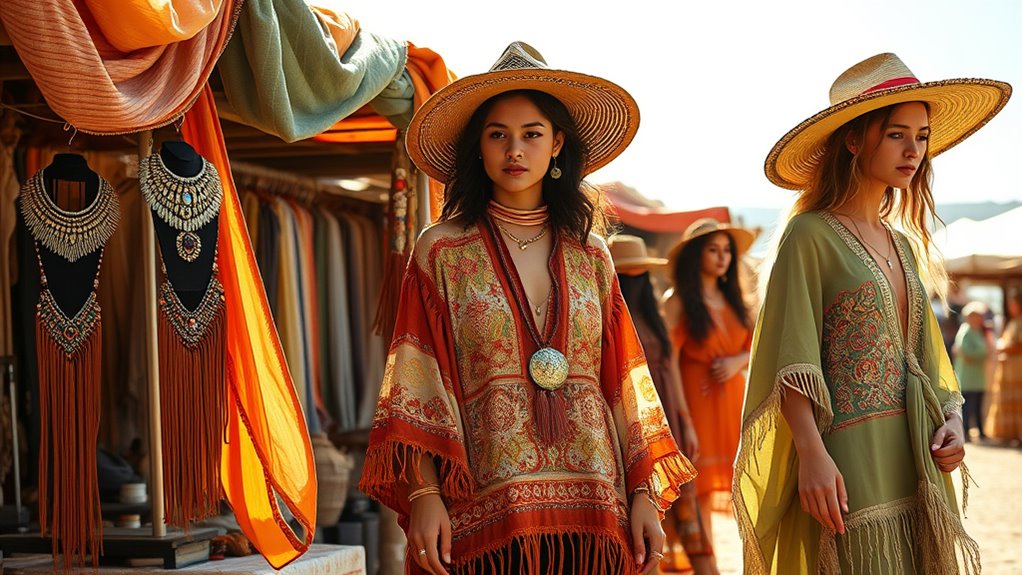
You can see how modern boho fashion now prioritizes eco-friendly materials like organic cotton and recycled fabrics to lessen environmental impact. Many brands work with fair-trade artisans, ensuring fair wages and sustainable practices. This shift encourages you to choose styles that support both ethical production and a more mindful approach to fashion.
Eco-Friendly Materials Usage
Have you noticed how modern boho fashion is shifting toward more sustainable choices? Today’s sustainable boho emphasizes eco-friendly materials like organic fabrics, recycled textiles, hemp, and bamboo. These materials reduce environmental impact while maintaining a relaxed, earthy aesthetic. Brands now prioritize ethical fashion by sourcing responsibly and supporting fair trade practices. Natural dyeing techniques further lower the ecological footprint, adding vibrant, detailed patterns without harmful chemicals. Many designers focus on eco-conscious design, creating pieces that are durable and versatile, encouraging you to buy less and wear longer. This shift aligns with a broader movement toward sustainability and social responsibility in fashion. Incorporating these eco-friendly materials helps preserve the environment and supports fair employment worldwide, making your style both beautiful and conscientious.
Fair Trade Practices
As the modern boho movement embraces sustainability, fair trade practices have become a pivotal aspect of ethical fashion. You’ll notice brands prioritize fair trade, ensuring artisans receive fair wages and work under ethical conditions. These brands often collaborate with Fair Trade-certified cooperatives in countries like India, Ethiopia, and Peru, helping preserve traditional craftsmanship such as embroidery and weaving, which supports cultural heritage. They also focus on using eco-friendly, ethically sourced materials like organic cotton, recycled fabrics, and natural dyes, aligning with fair trade principles. Consumers increasingly demand transparency and ethical production, pushing the industry toward more responsible practices. This emphasis on fair trade not only promotes sustainable materials but also fosters a more ethical, culturally respectful approach to modern boho fashion.
How to Incorporate the Evolving Boho Aesthetic Into Your Wardrobe
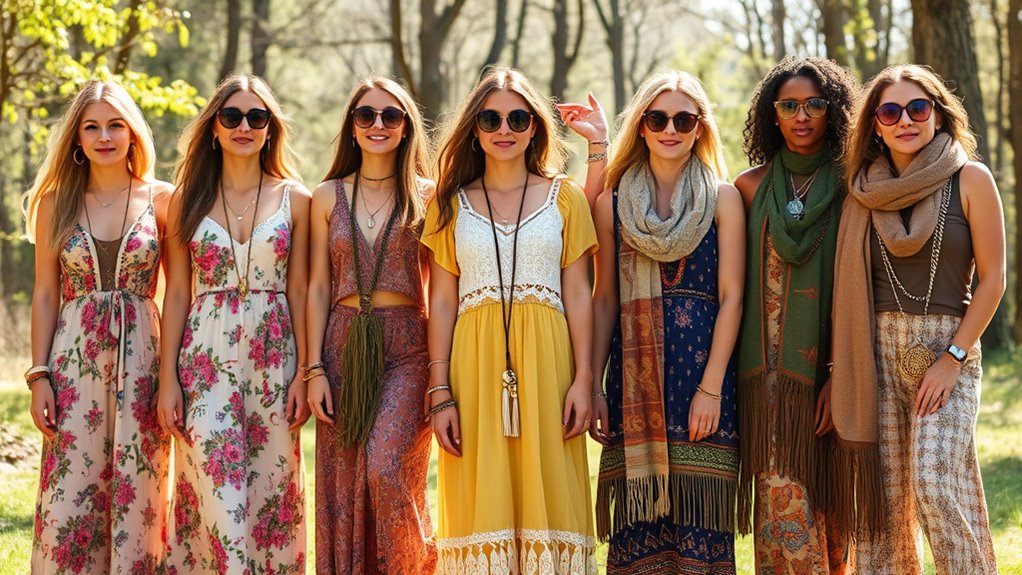
To incorporate the evolving boho aesthetic into your wardrobe, start by mixing vintage pieces like maxi skirts and embroidered blouses with modern accessories. This approach keeps your look fresh and eclectic, embodying modern boho. Layer flowing fabrics, earthy tones, and patterned textiles inspired by the 1960s and 70s to achieve a relaxed yet trendy style. Incorporate eco-friendly materials such as organic cotton and recycled fabrics to stay aligned with sustainability. Use statement jewelry, layered necklaces, and wide-brimmed hats to enhance your boho outfits and highlight the free-spirited vibe. For versatility, combine casual elements like denim jackets with elegant touches like crochet tops or floral dresses, making your boho style adaptable for any occasion.
- Vintage maxi skirts and embroidered blouses
- Layered necklaces and statement jewelry
- Earthy tones and flowing fabrics
- Eco-friendly materials in accessories and clothing
Frequently Asked Questions
What Is the Origin of Boho Style?
You might wonder where boho style comes from. It started in 18th-century Europe, where artists and writers embraced a free-spirited, unconventional lifestyle. They wore loose, colorful garments inspired by Romanticism, medieval patterns, and Eastern European designs. Rejecting formal fashion, they sought artistic expression and individuality. Over time, this rebellious, creative attitude shaped boho style into the eclectic, relaxed aesthetic you see today, rooted in a desire for freedom and personal expression.
What Is the History of Boho Clothing?
You might think boho clothing is just a modern trend, but its history runs deeper. Originating in the 19th century with French artists embracing unconventional fashion, it gained popularity in the 1960s counterculture, inspired by Romanticism and Eastern aesthetics. Over time, boho evolved from rebellious artist wear to mainstream fashion, celebrating individuality, comfort, and cultural influences—allowing you to express your unique style rooted in a rich, artistic history.
What Is the History of the Boho Theme?
You’re curious about the history of the boho theme. It started in the 19th century with artists and writers embracing a free-spirited, unconventional lifestyle. Inspired by the Bohemian movement, it rejected social norms with loose clothing and ethnic patterns. The term comes from the Roma people of Bohemia. In the 1960s, it gained popularity through the hippie movement, and today, it incorporates sustainability, vintage styles, and individual expression.
What Is the Difference Between Modern Boho and Boho?
Think of it as the difference between a free-spirited artist and a polished designer. Modern boho updates the relaxed, layered vibe of traditional boho with sleek fabrics, minimalism, and versatile styles, making it suitable for various occasions. You’ll notice it’s more curated and subtle, often emphasizing sustainability. Traditional boho, on the other hand, is more eclectic, relaxed, and heavily inspired by vintage, ethnic, and handmade elements.
Conclusion
From its rebellious 60s roots to today’s polished runway, boho style has evolved endlessly. It’s a free spirit grounded in history, yet constantly reshaped by modern values like sustainability. Embrace the contrast—mix vintage with contemporary, earthy tones with bold accents—and let your wardrobe tell a story as rich and diverse as boho itself. Whether laid-back or luxe, your style can honor its past while forging a fresh, ethical future.
